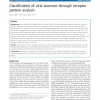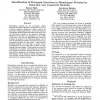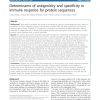37 search results - page 3 / 8 » Discriminating Microbial Species Using Protein Sequence Prop... |
BMCBI
2006
13 years 8 months ago
2006
Background: The splicing of RNA transcripts is thought to be partly promoted and regulated by sequences embedded within exons. Known sequences include binding sites for SR protein...
BMCBI
2011
13 years 3 months ago
2011
Background: Viral zoonosis, the transmission of a virus from its primary vertebrate reservoir species to humans, requires ubiquitous cellular proteins known as receptor proteins. ...
ISMB
1998
13 years 10 months ago
1998
Homologousproteins do not necessarily exhibit identical biochemicalfunction. Despitethis fact, local or global sequence similarity is widely used as an indication of functional id...
BMCBI
2011
13 years 4 days ago
2011
Background: Target specific antibodies are pivotal for the design of vaccines, immunodiagnostic tests, studies on proteomics for cancer biomarker discovery, identification of prot...
BMCBI
2010
13 years 8 months ago
2010
Background: Machine learning techniques have shown to improve bacterial species classification based on fatty acid methyl ester (FAME) data. Nonetheless, FAME analysis has a limit...



